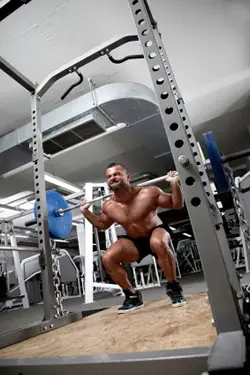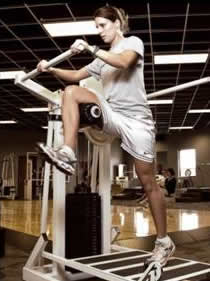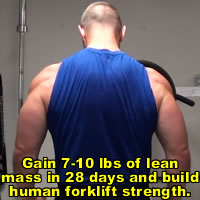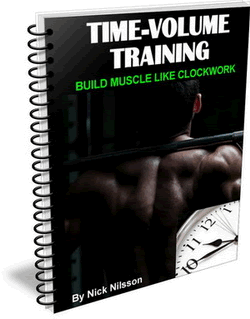Learning how to squat with your hamstrings is something most people don't even realize they SHOULD be doing.
After all, you CAN actually perform a squat without really activating the hamstrings.

That being said, it's actually VERY important that you learn how to squat with your hamstrings if you want to protect your knees and lower back and maximize the weight you can lift.
There are several reasons you want to get the hamstrings working when you squat.
1. Increased muscle activation means greater strength.
When you get the hamstrings involved, you'll be able to lift more weight because there will be more overall muscle mass contributing to the movement
.
2. Hamstring activation balances the torque in the knee joint that the quadriceps are placing on the knee during the squat.
One of the main reasons why the leg extension can be so tough on the knees is this unbalanced torque on the knee joint.
By increasing hamstring activation during the squat (out of the bottom, in the deepest point of the squat), you can balance out the forces on the knee joint and potentially get people who THINK they can't squat because of bad knees to successfully perform a squat. The squat goes from a knee-dominant exercise to a hip-dominant exercise.
And when I say this, I'm not saying this is ALWAYS the case...sometimes there really are structural issues in the knees that won't allow for squatting...this hamstrings CAN help in some cases, though.
3. Hamstring activation at the bottom of the movement helps to maintain the arch of the lumbar spine.
This happens at the bottom of the movement, helping to better stabilize the spine and protect the lower back.
To learn how to squat with the hamstrings, we're going to be focusing on their hip extension function.
The hamstrings have two major functions...knee flexion (which is the better known "leg curl" type of movement) and hip extension (which is bringing the thigh backwards).
|
First, you'll need to lighten up the weight. Load the bar with something you could easily get 15 to 20 reps with. We're going to be doing some stop-motion static holds at the bottom of the squat to help you learn to activate the hamstrings.
You CAN practice this doing just a bodyweight squat (especially if you do have any knee issues...in which case hold onto something in front of you and take it slow), but to be honest, I actually find it harder to activate the hamstrings without at least SOME added resistance. They just seem to need something to work against.
Unrack the bar and step back (I always recommend squatting in a rack for safety). Set your feet a little outside of shoulder-width apart...toes pointed out about 20 to 30 degrees.

Begin the squat by sitting back with your glutes. Don't start by bending the knees! You should always visualize sitting back first.
Come all the way down into the bottom position of the squat and hold there. Here's where you're going to learn how to activate the hamstrings.
We'll focus on the hips first...
And this may be a little vulgar but I want you to imagine that you're wiping something off your butt on a wall behind you (let's just say you've got paint on your butt cheeks or something because you sat a bench that just got painted).
THIS is the INTENTION of movement (even if you don't actually move) that you want to put into the action at the hips.
From a biomechanical perspective, you basically want to try to tilt your pelvis forward (anteriorly) as you come up. This puts greater tension on the hamstrings, increasing activation.
Try this for a couple of reps and see how it feels.

If you still aren't able to quite get it (or even if you are), you can try this next modification, focusing more down by the knee joint.
When you're at the bottom of the squat, try to imagine pushing your lower thigh hamstring area DOWNWARD towards the ground.
The method you can visualize this with is this...think of being on the Rotary Hip Machine with a leg over top of the pad, then bring your leg down and back.

The pad is contacting your leg down by the knee and THAT is the implied movement we're going for (a.k.a. the "intention" of the movement) there. This essentially results in resisted hip extension.
It's this intention of movement that really helps balance the forces at the knee joint, so if you do have any knee issues and want to try this technique, focus on THIS part more so than what's happening at the hip.
Bottom line, as you can see in the pic above of me at the bottom of the squat (where I have the red arrows), we're actually almost looking for a "rotary" type intention of movement in the thigh and hip. The hip is rotating up and forward and the lower thigh is rotating down and backward.
If you find you STILL can't get it, another trick I like to use is to do a set of stiff-legged deadlifts right before squatting...not heavy, but just enough to "wake up" the hamstrings and get them activated so they're easier to feel in this squat movement (you could potentially even do a light set of leg curls if you also can't feel your hams during Stiff-Legged Deadlifts , too).
This is going to take some practice so don't worry if you don't nail it right away.
It is absolutely critical that you use a light enough weight that you can stop in the bottom position of the squat and really get your mind into the muscles and focus on these activation techniques without worrying about whether or not you'll be able to come back up.
When you get it, you'll feel the hamstrings tightening up and contributing to the movement out of the bottom. It's a great "ah-ha!" moment that will change the way you look at squatting forever.
No longer will you look at the squat solely as a quad exercise.
I HIGHLY recommend working on this technique as a warm-up before every single squat session you do. It's a great way to achieve improve your form and really learn how to use ALL the muscles in your lower body to perform a squat.
When you perform perfect practice frequently like this, you'll develop that mind-muscle connection and (hopefully) begin to do this automatically, even when squatting with heavier weights.
Learning how to activate the hamstrings when you squat will help you squat more weight, with better body position and with less stress on your knees.
These are three MAJOR benefits that make this technique absolutely worth your while to learn.
Learn 16 more methods for improving your squat form here.
![]()
More From Fitstep.com
| The 7 Biggest Training Mistakes I've Ever Made | |
| How Do I Get Rid of My Man-Boobs? | |
| 7 Simple Rules for What You Should Eat | |
| The Best Bodyweight Chest Exercise...One-Arm Bench Push-Ups |
Share This Page...
---
Home -> Exercise Library -> Hamstring and Adductor Exercises -> Squat With Hamstrings



